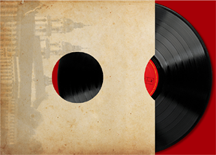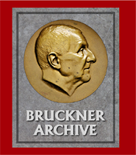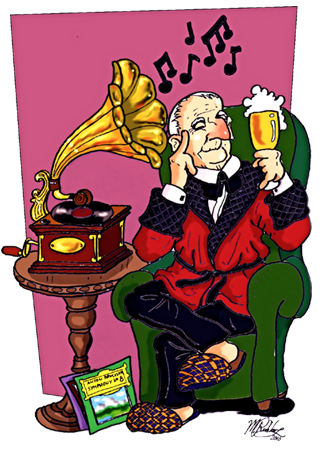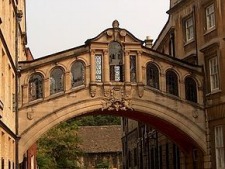Conference Activity Log
Later, we met up with Benjamin Korstvedt (one of the conference presenters) and we stopped by London's little-known Bruckner plaque in Finsbury Square (see photo). Then after a meal at an Italian restaurant, we attended a Philharmonia Orchestra concert which included a performance of Bruckner's Symphony No. 3 (1889 Nowak). Kurt Masur was the scheduled conductor, but a broken hip forced him to cancel his appearance so we heard the symphony conducted by Thomas Dausgaard. Friday, April 12: Today we departed for Oxford via a double-decker bus from central London. Upon arrival, we checked into our rooms and then went to set up the conference room. It is our hope to videotape the presentations and to offer them on DVD. Next, we went to "The Mitre," an old restaurant in Oxford. One could gauge its age by the photos which showed horses tied up in front of the building. We returned to the campus for the official opening of the conference. Ken Ward made opening comments and then we heard from our first two speakers both which presented a psychological analysis of Bruckner's creative process. Malcolm Hatfield opened with a presentation that focused on Bruckner's reaction to the news of Hermann Levi's rejection of the Symphony No. 8. By attempting to understand Bruckner's thought process one can gain some possible perspective on how he would have reacted during this emotional and professional crisis. We then heard from Abram Chipman who also presented a narrative of Bruckner the man as seen through a psychological lens. Both presentations provided viable explanations for what is often referred to as Bruckner's unusual behavior and helped to dispel some of the simplistic descriptions (obsessive compulsive disorder; the country bumpkin genius, etc.) that have often been presented as explanations for Bruckner's unique personality. Saturday, April 13: After breakfast, the conference resumed with a day-long slate of speakers. Paul Coones from Hertford College told us of his experiences conducting Bruckner with the Hertford Bruckner Orchestra. It was an insightful and humorous talk that gave all of us a better appreciation of the conductor's role before an orchestra. Louis Lohraseb was unable to attend due to a flight cancellation but he did e-mail his presentation paper which was read by Ken Ward. The paper dealt with the many differences that can be found between the Haas/Nowak printed editions of the Symphony No. 6 and the first published edition. William Carragan gave a presentation that went into detail to describe the differences between the 1873, 1877, 1889 and his 1874 variant to the Symphony No. 3. Audio examples were presented along with a 44 page booklet of score illustrations. Andrea Harrandt from Vienna gave a presentation on the relationship between Anton Bruckner and Richard Wagner. It showed that while they had great admiration for each other's work, each did little to further the career of the other. The presentation was parallel to an exhibition that was recently presented at the Austrian National Library. Paul Hawkshaw from Yale University provided an update on his research into the sources of the Symphony No 8. His major findings were: These remarkable findings vindicate Haas for his editorial work on the Eighth Symphony (but not necessarily for his work on the Second Symphony), yet it more openly calls into question Haas' vehement condemnation of the first published editions which, in many cases, went to press with Bruckner's approval. Geoffrey Hosking presented a paper on Austrian composer Egon Wellesz and links to Bruckner's music to be found in Wellesz's Second Symphony. The conference presentations concluded with Benjamin Korstvedt from Clark University updating us on his extensive studies of Bruckner's Fourth Symphony. He supplied a timeline and examples of how the symphony evolved between 1874 and 1890. He concluded his presentation with an excerpt of a newly released video of Franz Welset-Moest conducting the Cleveland Orchestra in a performance of the 1888 Korstvedt edition of the Symphony No. 4. After a break for dinner, conference attendees and members of the public assembled in the Hertford College Chapel to hear the world premiere performance of Bruckner's Symphony No. 4 in the first version of 1874 as transcribed for two pianos, four hands. These piano transcriptions were usually published in conjunction with the corresponding orchestral score. Before the days of recordings, these piano transcriptions were required for anyone to be able to hear an orchestral composition outside of the concert hall. Since this early edition was not published until the 1970's no such transcription was prepared. William Carragan produced the transcription and performed it with Crawford Howie. Sunday, April 14: After a breakfast in the Hertford College dining hall, we said goodbye to our colleagues and Ken and I returned to London where he gave me the abbreviated tour of London (Parliament, Big Ben, Buckingham Palace and Royal Albert Hall). We retraced Bruckner's footsteps to the Kensington underground (subway) station. Monday, April 15: Monday was a travel day. I took the long underground ride to Heathrow and took my return flight to Toronto and then on to Hartford. The only issue of note during the flight was as the plane approached the coast of Newfoundland, I recalled that this was the site of the sinking of the Titanic. As I looked down, I thought about that tragic event at took place 101 years ago to the day... |







